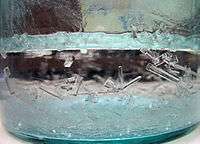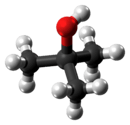tert-Butyl alcohol
| |||
 | |||
| Names | |||
|---|---|---|---|
| Preferred IUPAC name
2-Methylpropan-2-ol | |||
| Other names | |||
| Identifiers | |||
| 75-65-0 | |||
| 3D model (Jmol) | Interactive image | ||
| 906698 | |||
| ChEBI | CHEBI:45895 | ||
| ChEMBL | ChEMBL16502 | ||
| ChemSpider | 6146 | ||
| DrugBank | DB03900 | ||
| ECHA InfoCard | 100.000.809 | ||
| EC Number | 200-889-7 | ||
| 1833 | |||
| MeSH | tert-Butyl+Alcohol | ||
| PubChem | 6386 | ||
| RTECS number | EO1925000 | ||
| UNII | MD83SFE959 | ||
| UN number | 1120 | ||
| |||
| |||
| Properties | |||
| C4H10O | |||
| Molar mass | 74.12 g·mol−1 | ||
| Appearance | Colorless liquid | ||
| Odor | Camphorous | ||
| Density | 0.775 g/mL | ||
| Melting point | 25 to 26 °C; 77 to 79 °F; 298 to 299 K | ||
| Boiling point | 82 to 83 °C; 179 to 181 °F; 355 to 356 K | ||
| miscible[3] | |||
| log P | 0.584 | ||
| Vapor pressure | 4.1 kPa (at 20 °C) | ||
| Acidity (pKa) | 16.54 [4] | ||
| Refractive index (nD) |
1.387 | ||
| Thermochemistry | |||
| 215.37 J K−1 mol−1 | |||
| Std molar entropy (S |
189.5 J K−1 mol−1 | ||
| Std enthalpy of formation (ΔfH |
−360.04–−358.36 kJ mol−1 | ||
| Std enthalpy of combustion (ΔcH |
−2.64479–−2.64321 MJ mol−1 | ||
| Hazards | |||
| Safety data sheet | inchem.org | ||
| GHS pictograms |   | ||
| GHS signal word | DANGER | ||
| H225, H319, H332, H335 | |||
| P210, P261, P305+351+338 | |||
| EU classification (DSD) |
| ||
| R-phrases | R11, R20, R36/37 | ||
| S-phrases | (S2), S9, S16, S46 | ||
| NFPA 704 | |||
| Flash point | 11 °C (52 °F; 284 K) | ||
| 480 °C (896 °F; 753 K) | |||
| Explosive limits | 2.4–8.0% | ||
| Lethal dose or concentration (LD, LC): | |||
| LD50 (median dose) |
3559 mg/kg (rabbit, oral) 3500 mg/kg (rat, oral)[5] | ||
| US health exposure limits (NIOSH): | |||
| PEL (Permissible) |
TWA 100 ppm (300 mg/m3)[2] | ||
| REL (Recommended) |
TWA 100 ppm (300 mg/m3) ST 150 ppm (450 mg/m3)[2] | ||
| IDLH (Immediate danger) |
1600 ppm[2] | ||
| Related compounds | |||
| Related butanols |
2-Butanol | ||
| Related compounds |
2-Methyl-2-butanol Trimethylsilanol | ||
| Except where otherwise noted, data are given for materials in their standard state (at 25 °C [77 °F], 100 kPa). | |||
| | |||
| Infobox references | |||
tert-Butyl alcohol (TBA), also called tert-butanol, is the simplest tertiary alcohol, with a formula of (CH3)3COH (sometimes represented as t-BuOH). It is one of the four isomers of butanol. tert-Butyl alcohol is a colorless solid, which melts near room temperature and has a camphor-like odor. It is very soluble in water and miscible with ethanol and diethyl ether.
Natural occurrence
t-Butyl alcohol has been identified in beer and chickpeas.[6] It is also found in cassava[7] which is used as fermentation ingredient in certain alcoholic beverages.
Preparation
tert-Butyl alcohol is derived commercially from isobutane as a co-product of propylene oxide production. It can also be produced by the catalytic hydration of isobutylene, or by a Grignard reaction between acetone and methylmagnesium chloride.
Purification can not be performed by simple distillation due to formation of an azeotrope with water, although initial drying of the solvent containing large amounts of water is performed by adding benzene to form a tertiary azeotrope and distilling off the water. Smaller amounts of water are removed by drying with CaO, K2CO3, CaSO4, or MgSO4, followed by fractional distillation. Anhydrous t-butanol is obtained by further refluxing and distilling from magnesium activated with iodine, or alkali metals such as sodium or potassium. Other methods include the use of 4A MO sieves, aluminum tert-butylate, CaH2, or fractional crystallization under inert atmosphere.[8]
Applications
tert-Butyl alcohol is used as a solvent, ethanol denaturant, paint remover ingredient, and gasoline octane booster and oxygenate. It is a chemical intermediate used to produce MTBE and ETBE by reaction with methanol and ethanol, and TBHP by reaction with hydrogen peroxide.
Reactions
As a tertiary alcohol, tert-butyl alcohol is more resistant to oxidation and less reactive than the other isomers of butanol.
When tert-butyl alcohol is deprotonated with a strong base, the product is an alkoxide anion. In this case, it is tert-butoxide. For example, the commonly used organic reagent potassium tert-butoxide is prepared by refluxing dry tert-butanol with potassium metal.[9]
- K + tBuOH → tBuO−K+ + 0.5 H2
The tert-butoxide is a strong, non-nucleophilic base in organic chemistry. It readily abstracts acidic protons from substrates, but its steric bulk inhibits the group from participating in nucleophilic substitution, such as in a Williamson ether synthesis or an SN2 reaction.
tert-Butyl alcohol reacts with hydrogen chloride to form tert-butyl chloride.
It also reacts with sodium in liquid ammonia.
References
- ↑ "Alcohols Rule C-201.1". Nomenclature of Organic Chemistry (The IUPAC 'Blue Book'), Sections A, B, C, D, E, F, and H. Oxford: Pergamon Press. 1979.
Designations such as isopropanol, sec-butanol, and tert-butanol are incorrect because there are no hydrocarbons isopropane, sec-butane, and tert-butane to which the suffix "-ol"can be added; such names should be abandoned. Isopropyl alcohol, sec-butyl alcohol, and tert-butyl alcohol are, however, permissible (see Rule C-201.3) because the radicals isopropyl, sec-butyl, and tert-butyl do exist.
- 1 2 3 4 "NIOSH Pocket Guide to Chemical Hazards #0078". National Institute for Occupational Safety and Health (NIOSH).
- ↑ http://www.inchem.org/documents/icsc/icsc/eics0114.htm
- ↑ Reeve, W.; Erikson, C.M.; Aluotto, P.F. Can. J. Chem, 1979, 57, 2747.
- ↑ "Tert-Butyl alcohol". Immediately Dangerous to Life and Health. National Institute for Occupational Safety and Health (NIOSH).
- ↑ http://toxnet.nlm.nih.gov/cgi-bin/sis/search/a?dbs+hsdb:@term+@DOCNO+50
- ↑ http://www.sc.mahidol.ac.th/scbc/bc_internet/publication/696.pdf
- ↑ Purification of Laboratory Chemicals, 3rd Edition. D.D. Perrin, W.L.F. Armarego. 1988, Pergamon Press Ltd.
- ↑ Johnson, W. S.; Schneider, W. P. (1950). "β-Carbethoxy-γ,γ-diphenylvinylacetic acid". Org. Synth. 30: 18.; Coll. Vol., 4, p. 132
External links
- International Chemical Safety Card 0114
- "NIOSH Pocket Guide to Chemical Hazards #0078". National Institute for Occupational Safety and Health (NIOSH).
- IPCS Environmental Health Criteria 65: Butanols: four isomers
- IPCS Health and Safety Guide 7: tert-Butanol


